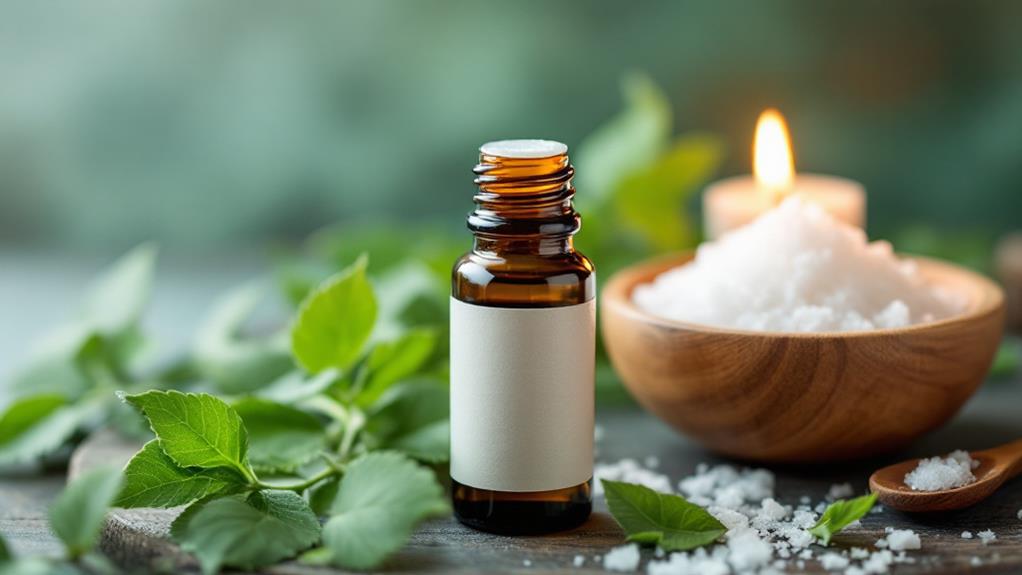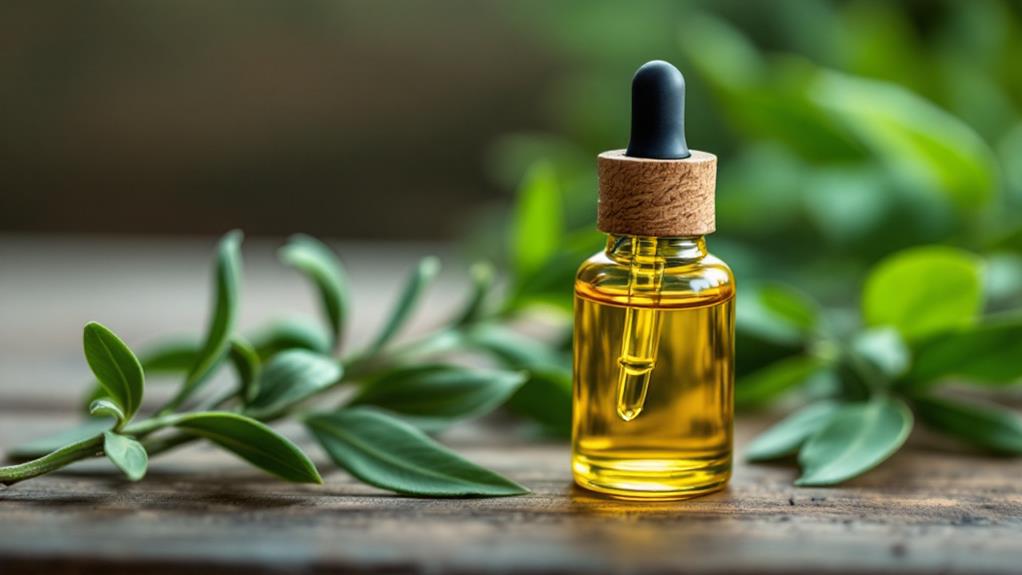How to Use Tea Tree Oil to Treat Psoriasis: A Step-by-Step Guide
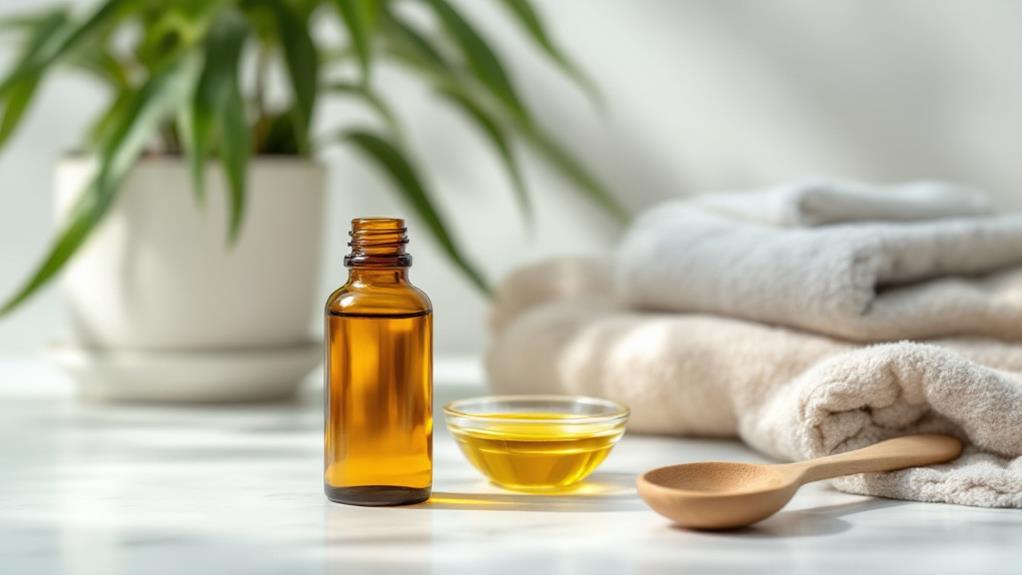
Start by diluting tea tree oil with a carrier oil at a 1:10 ratio to minimize skin irritation. Conduct a patch test by applying this mixture to a small skin area and wait 24 hours. If there's no reaction, you can apply it directly to psoriasis patches. For scalp issues, blend tea tree oil into your shampoo or massage it with a carrier oil onto your scalp, leaving it for 10-15 minutes. Use this treatment 2-3 times a week for the best results. Keep exploring to unearth more tips and precautions to enhance your psoriasis care routine.
Understanding Psoriasis
While psoriasis is a complex condition, understanding its basic nature can help you manage it more effectively. Psoriasis is a chronic skin disorder driven by an overactive immune system. This leads to a rapid increase in skin cell production, resulting in the formation of dry, thick, and scaly patches. These scaly patches often appear as red patches covered with silvery scales, causing inflammation and irritation. You might notice itchy skin or even experience pain, depending on the severity of your symptoms.
Medical experts recognize psoriasis as affecting about 2-3% of the global population. It manifests in different forms, including plaque psoriasis, guttate psoriasis, and psoriatic arthritis. The condition can affect diverse body parts such as the lower back, elbows, knees, and scalp. Symptoms can differ widely from person to person, both in presentation and intensity, making it a unique challenge to manage.
Understanding the role of the immune system in psoriasis is vital. The accelerated skin cell production means your body is creating new cells faster than it can shed old ones, leading to the characteristic symptoms. Being informed can empower you to seek appropriate treatments and make lifestyle adjustments.
Benefits of Tea Tree Oil
Among the natural remedies for psoriasis, tea tree oil stands out due to its potent antibacterial, anti-inflammatory, and antioxidant properties. These qualities make it a powerful contender in psoriasis treatments, helping to reduce inflammation and soothe psoriasis symptoms effectively. By regulating sebum production, tea tree oil keeps your skin from becoming too oily or dry, maintaining a healthy balance that's essential for managing psoriasis.
Here are three key benefits of using tea tree oil for psoriasis:
- Anti-inflammatory properties: Tea tree oil helps reduce inflammation, a predominant issue in psoriasis, providing relief from redness and swelling.
- Exfoliating dead skin cells: It aids in removing dead skin cells, which promotes a healthier skin appearance by reducing scaling commonly associated with psoriasis.
- Antimicrobial properties: The oil's natural antimicrobial properties help relieve itchiness, a bothersome symptom for many with psoriasis.
For scalp psoriasis, tea tree oil is particularly beneficial. It effectively exfoliates oily scales, improving scalp health and alleviating discomfort. Its soothing effect can minimize itchiness, making it a versatile supplement to your psoriasis treatment regimen. With its range of benefits, tea tree oil is a natural remedy worth considering for managing psoriasis symptoms.
Conducting a Patch Test
Before you dive into using tea tree oil for psoriasis, conducting a patch test is vital to confirm you don't experience any adverse reactions. This step is imperative, especially if you have sensitive skin, as tea tree oil can sometimes cause irritation. Start by creating a mixture of diluted tea tree oil and a carrier oil or water at a 1:10 ratio. This helps minimize the risk of an allergic reaction. Apply a small amount of this mixture to a discreet area, like the inside of your forearm, where skin sensitivity can be easily monitored.
After applying, wait 24 hours without washing it off to see if any adverse reactions develop. Look for signs of irritated skin, such as redness or itching, which can indicate an allergy. If you notice any of these symptoms, it's significant to discontinue use immediately. In such cases, consult a healthcare professional to investigate alternative treatments for your psoriasis.
If no negative reactions occur after the 24-hour period, you can generally consider it safe to use tea tree oil on psoriasis-affected areas. This careful approach guarantees you avoid unnecessary skin issues while examining natural remedies.
Proper Dilution Techniques
Proper dilution of tea tree oil is crucial when using it to treat psoriasis, as it helps reduce the risk of skin irritation. To achieve the right balance, you'll want to mix 1 part tea tree oil with 10 parts of a carrier oil like olive or coconut oil. This dilution ratio minimizes potential irritation while guaranteeing effectiveness. Before applying it broadly, conduct a patch test on a small skin area to verify you don't experience an allergic reaction or sensitivity.
Here's how to proceed with proper dilution techniques:
- Select Your Carrier Oil: Choose oils like olive or coconut for their moisturizing benefits, which complement tea tree oil's properties.
- Maintain the Dilution Ratio: Always keep the 1:10 ratio in mind, even when blending into products like shampoos to treat scalp psoriasis.
- Perform a Patch Test: Apply a small amount of the diluted mixture on a patch of skin to check for any adverse reactions.
For topical application, use a cotton ball to apply the mixture directly onto psoriasis patches. Afterward, use a moisturizer to maintain hydration and prevent excessive dryness, guaranteeing your skin remains balanced and healthy.
Application Methods
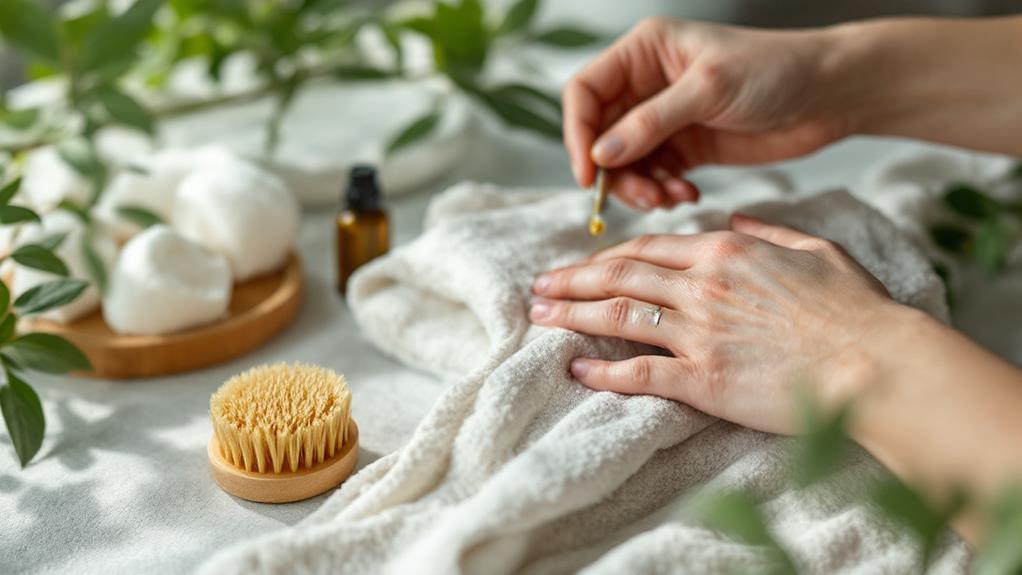
Once you've mastered the art of dilution, it's time to focus on how to apply tea tree oil effectively for psoriasis relief. Start by conducting a patch test on a small area of skin to verify there's no allergic reaction. When you're ready to apply, make certain your tea tree oil is properly diluted with a carrier oil like olive or coconut oil, using the ratio of 1 part tea tree oil to 10 parts carrier oil. This guarantees safe application and reduces irritation.
For treating psoriasis patches, gently apply a sufficient layer of the diluted oil directly onto the affected areas. Allow it to sit for 10-15 minutes before rinsing off with warm water. This aids in managing psoriasis symptoms by soothing and reducing inflammation.
If you're targeting scalp psoriasis, incorporate a few drops of tea tree oil into your regular shampoo. Massage it into your scalp, assuring even distribution, and leave it on for a few minutes before rinsing thoroughly.
To enhance the benefits, maintain a consistent treatment routine, applying the tea tree oil mixture 2-3 times a week. This regular application can considerably help in alleviating psoriasis symptoms over time.
Managing Scalp Psoriasis
Although dealing with scalp psoriasis can be challenging, an effective management strategy can provide significant relief. One natural remedy you can use is tea tree oil, renowned for its anti-inflammatory properties. To manage scalp psoriasis, dilute tea tree oil in a carrier oil like coconut or mineral oil. Massage this mixture into your scalp and let it sit for 10-15 minutes before rinsing. This can help reduce inflammation, moisturize the scalp, and soften scales, making it easier to manage symptoms.
Regularly incorporating other natural remedies can improve your management efforts. For instance, Dead Sea salt baths are excellent for reducing inflammation. Spend about 15-20 minutes soaking in warm water with added salt to further alleviate itchiness and discomfort.
Here's a quick guide to help manage scalp psoriasis:
- Tea Tree Oil Treatment: Dilute with a carrier oil, massage into the scalp, and rinse after 10-15 minutes.
- Moisturizing Routine: Use coconut or mineral oil regularly to moisturize and reduce itchiness.
- Salt Baths: Soak in Dead Sea salt baths for 15-20 minutes to relieve inflammation.
Combining these natural remedies with other treatments can lead to a more thorough approach in managing scalp psoriasis symptoms.
Potential Risks and Precautions
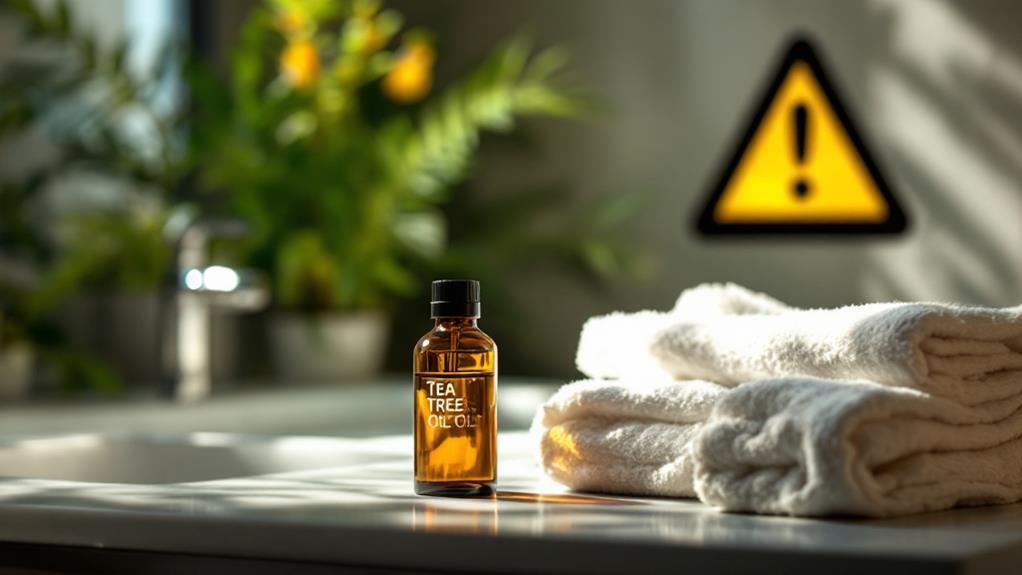
When considering the use of tea tree oil for psoriasis, it is vital to be aware of potential risks and take necessary precautions. Initially and foremost, if you have known allergies to tea tree oil, avoid using it, as it can trigger allergic reactions like red, itchy eruptions on your skin. For those without known allergies, patch testing is fundamental. Apply a small amount of the oil to a discreet area of your skin and wait 24 hours to check for any irritation or sensitivity. This step can prevent unwanted flare-ups or contact dermatitis.
Pregnant women should be particularly cautious, as increased skin sensitivity during pregnancy can lead to irritation or adverse effects from tea tree oil. Always consult a dermatologist before using the oil, especially if you have severe skin conditions. This professional guidance can help you navigate any potential issues safely.
Additionally, not all tea tree oil products are created equal. Verify you choose a high-quality, pure oil to minimize the risk of irritation from additives. By taking these precautions, you can safely investigate the potential benefits of tea tree oil for managing psoriasis.
Alternative Natural Remedies
Some might find relief from psoriasis through alternative natural remedies that harness the power of nature's anti-inflammatory properties. Besides Tea Tree Oil, several other options can help reduce symptoms and provide relief. Here are three natural treatments you might consider:
- Aloe Vera: Known for its soothing and anti-inflammatory properties, applying pure aloe vera gel for 15-20 minutes can help manage psoriasis symptoms. This remedy reduces redness and irritation, making it a valuable addition to your psoriasis care routine.
- Omega-3 Fatty Acids: Incorporate omega-3-rich foods into your diet or consider supplements. These crucial oils, found in fish oil, can reduce inflammation and improve skin health, offering a natural way to manage skin conditions like psoriasis.
- Oatmeal Baths: Soaking in a bath with ground oats can effectively relieve itchiness and provide a soothing effect on irritated skin. This remedy's simplicity and effectiveness make it a popular choice for those seeking natural treatments.
After trying these remedies, don't forget the importance of moisturizing afterward. This step guarantees your skin remains hydrated, helping to maintain the benefits gained from these natural approaches.


